HP w2408: A "New" Twist on 24" LCDs
by Jarred Walton on December 21, 2007 5:00 AM EST- Posted in
- Displays
Uncalibrated
Results
Brightness and Contrast Ratio
For the brightness, contrast, and color accuracy tests, we depend on the hardware colorimeter and software to help calibrate the displays. As previously stated, we use a Monaco Optix XR (DTP-94) colorimeter and Monaco Optix XR Pro software. The software and hardware help users to get color that is more accurate from their displays. Before we get to the calibrated results, we took a quick look at the range of brightness and contrast at stock settings while changing just the brightness level.
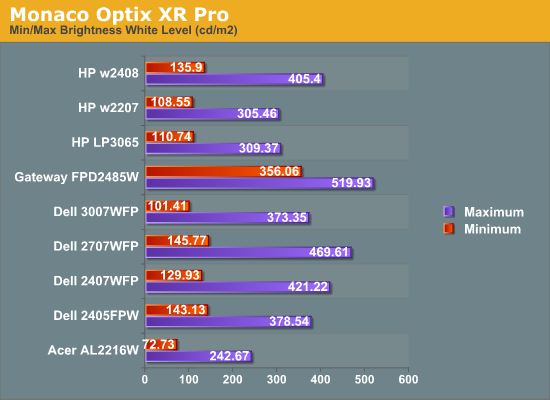
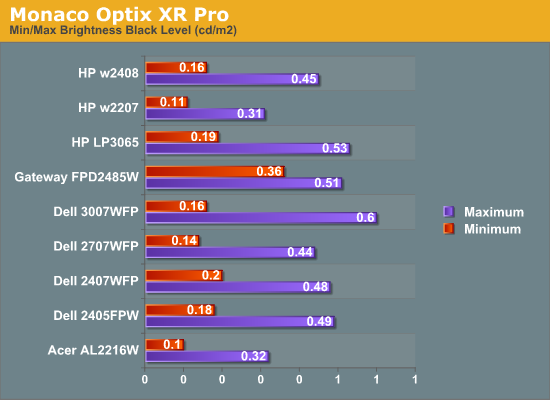
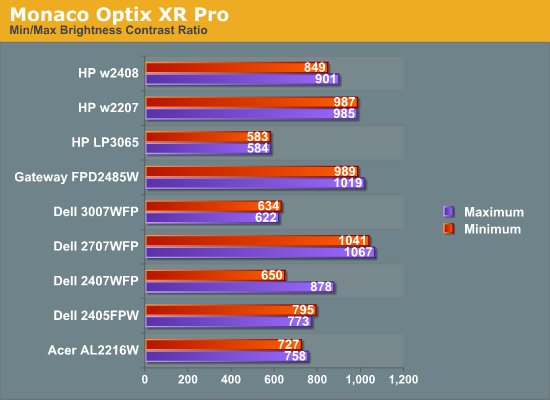
The maximum brightness level of just over 400 nits is more than most people need, though prior to calibration we fall just short of the stated 1000:1 contrast ratio. With further tuning of the color levels, the HP w2408 can accommodate any reasonable brightness setting while maintaining between an 800:1 and 1000:1 contrast ratio. Getting optimal settings at lower brightness levels may require more work, however.
Color Accuracy
The problem with calibrating a display is that it doesn't help all applications. Specifically, the video overlay used when watching DVDs or other movies completely bypasses any color profiles, so you are stuck with the uncalibrated colors. Playing games also uses the default color options. It is possible to tweak things using the OSD, but the amount of color correction that can be done via the OSD pales in comparison to color correction tables, and some LCDs (the Dell 3007WFP and HP LP3065 for example) are unable to adjust anything but brightness outside of software. Ideally, we would like to see video drivers begin to apply color profiles to all output - office applications, movies, games, or anything else.
For uncalibrated color accuracy, we adjust the brightness as well as the contrast and colors (where applicable) using a "calibrate by eye" chart and the OSD controls. Also remember that color accuracy can vary from panel to panel even within the same model, and the results we are reporting are only from testing a single LCD. During testing, Monaco Optix XR Pro sends 24 color patches to the display with the colorimeter measuring the resulting values. The difference between what the requested and actual colors shown on the LCD is Delta E, with lower values being better. Any score less than one is basically "perfect" - the naked eye is not going to be able to tell the difference - and scores less than 2.0 are nearly perfect.
Ideally, you would want all of the tested colors to have a Delta E of less than 1.0, but almost no one is likely to have problems with anything scoring below 2.0. From 2.0 to 4.0, most people still won't notice the slight inaccuracies in the color palette, but when comparing displays side-by-side, differences may be apparent - multimedia professionals in particular would prefer better colors. Anything above 4.0 begins to represent a more significant deviance, and numerous scores above 6.0 will almost certainly be noticeable by anyone using the display. Consistency is also important, so a display that has very good scores overall but with high spikes on some colors may actually be less desirable than a display with a slightly higher but more consistent average Delta E. Note also that fluctuations of as much as one point in Delta E are possible during a short amount of time. It generally takes 30 minutes for a display to warm up, and we perform all of our calibration and testing after the displays have been running for at least one hour with the screensaver disabled.
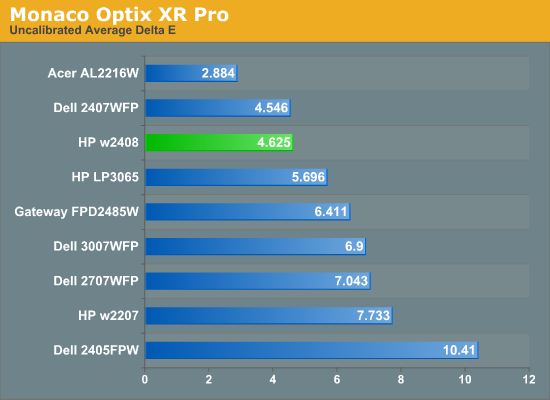
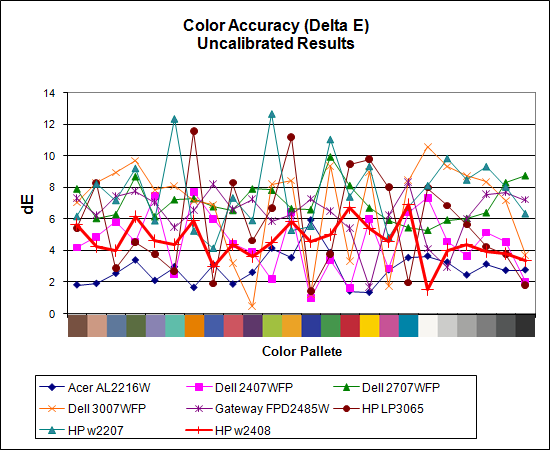
Without any form of color correction, the HP w2408 rates a decent (relative to the competition) 4.6, ranking third just slightly behind the 2407WFP. We continue our quest for an LCD that can generate nearly perfect colors without any user calibration, but that quest appears to be in pain. Still, at least the w2408 is mostly consistent -- all of the scores are below 7.0, and most are between 4.0 and 6.0.










30 Comments
View All Comments
Pirks - Friday, December 21, 2007 - link
1) Question to AT - when do you guys intend to review any of the latest 28" LCD monitors? There are at least two of them at newegg, ViewSonic and Hanns-G2) Question to AT readers - have anyone tried to use something like 37" Westinghouse LCD TV (1920x1080) with their PC as a main monitor? I've got a buddy who has Mac Mini connected to such a TV and he swears this TV is the best monitor one can dream about. Could someone share their experience?
3) Question to AT - do you guys think about revieweing say 37" Westy as a PC monitor? Test response, color, tell us what the panel is (TN film I suppose?) - all the usual tests.
I'm thinking about upgrading to widescreen, and since 1080p Westys are so cheap these days (especially 37" one) I'm seriously considering them too, so please please share your experience if you have one, thanks!
I'm kind of puzzled why AT ahven't realized such an obvious thing as using Westy 1080p as the main PC monitor, why no reviews, nothing... they just review eithet uberduperexpensive 2560x1600 panels, or some smaller cheapo ones like 24" - and no 28? No 37" TV? No 42" or 47" TV? I'm talking about 1080p LCD TVs here.
That's just weird - there must be something wrong with using those TVs as PC monitors or else we'd seen such a review from AT a loong time ago, I guess...
timmiser - Friday, December 28, 2007 - link
"when do you guys intend to review any of the latest 28" LCD monitors? There are at least two of them at newegg, ViewSonic and Hanns-G"I've got the Hanns-G 28" monitor from Costco earlier this month and absolutely love it. First of all, because it is Costco, I have a lifetime, full money back, satisfaction guarantee and it only cost $499 which of course is much less than this 24". It also can be used as a full HD 1080p monitor as it has HDMI hookup.
The monitor itself has been great. I use it quite a bit for gaming and no complaints so far but I must admit I am no expert monitor reviewer either. It replaced my old Dell 20" widescreen.
Johnmcl7 - Saturday, December 22, 2007 - link
I have a 40 inch Samsung 1080p which I use as a monitor but not as a day to day one, personally I think it's just far too physically big for that. To use it properly I need to sit a fair distance back, it's normally only for placing back media and occasionally photo work.If I could get dual DVI out of my laptops (can't find a cheap dual link DVI PCI card to use in their dock) I'd pick up a 30 inch Dell - personally that's the upper limit on size for using as a monitor.
John
somedude1234 - Saturday, December 22, 2007 - link
I have the Westy lvm-37w1 in my living room. While I haven't used it primarily as a PC monitor, the times that I have it has been perfect: absolutely beautiful at 1080p over either DVI or VGA. Using it to upscale DVD's playing on my laptop Dell D810 (VGA) is fantastic. HD sample footage and playback from hdhomerun (OTA) look amazing as well.The biggest flaw in this monitor is the backlight bleed in the corners, obvious when watching DVD's, but not a problem for PC use.
I'm eventually going to replace this in the living room with a better TV for movie & TV use, but this one will be kept busy as well.
JarredWalton - Friday, December 21, 2007 - link
Actually, it's really just an issue of getting companies to send us product for review. LCDs aren't cheaper, and neither are HDTVs. Westinghouse sent me their 42" 1080p display back in July. Unfortunately, UPS wasn't a good shipping choice. I noticed the box had a rip, and it turned out that the panel inside was shattered. They never did offer to send me another test unit for some reason. After trying to get one for testing for ~8 months only to have it damaged in shipping, I'm not holding my breath for seeing another any time soon.That said, CES is in January and I will be doing my best to hit up all of the display companies to see about getting some review samples sent my way. I'd love to be able to do a roundup of 24", 22", 27", etc. LCDs, though for roundups I'll have to trim down some of the writing and graphs in order to keep things manageable most likely.
Here's a question in return: Out of the stuff I'm currently discussing in display reviews, what do you find good, what do you find lacking? I'd like to do color gamut testing, but I don't have the hardware for that right now. I don't even know how big of a difference it is for most users - I mean, side-by-side I can see color differences between various displays, but using each individually, it's a lot more difficult to say which is better.
The one problem with HDTVs as computer displays appears to be in regards to signal processing. Some displays do extra work (i.e. deinterlacing, noise reduction, whatever) and they introduce noticeable lag - around 50ms I've heard. There's also the issue of finding room on your desk for a 37" or 42" display... I've got a 30" LCD and it's almost too big at times. HDTVs don't have height, tilt, pivot, or rotate features either, or USB ports on most. They probably end up best for movie/video use, good for gaming, and not so great for standard office work.
If I get one for review, I'll see what I can say about it, but honestly reviewing such hardware is a daunting task. Do we review as an HDTV with computer options, as a computer display with TV options, both? I can do the computer display review, but HDTV reviews aren't something I feel really qualified to handle.
Inkjammer - Saturday, December 22, 2007 - link
[quote]Do we review as an HDTV with computer options, as a computer display with TV options, both?[/quote]Review it as a "multimedia monitor". Something that can be used for multiple purposes. Right now, I'm using a 24" BenQ FP241VW, which is self proclaimed the "ultimate gaming PC monitor". It's connected to my C2D box, a 360, PS3 and some cable TV. As a gaming monitor it's decent, but all the extra features it has are absolutely useless in every aspect. For console gaming it leaves a LOT to be desired - my games look slightly washed out and like they're running in 16-bit color. Bioshock 360 looked really bad in dark areas. And as TV it's average as can be.
Now, in comparison...
I used to use a Viewsonic 32" LCD TV (1366x768) for my PC, console gaming and TV. Despite the resolution, I always felt it did everything great. Games, movies, computing. Blacks were so-so, but colors were great and it had a superb response time.
And that's what got me. My dedicated "gaming" monitor was only really really useful as as monitor, yet the cheap LCD TV I got was great at everything. So the aspect of having a monitor good at multiple forms of media (PC, consoles, TV) is really the selling point for an enthusiast like myself.
strikeback03 - Monday, December 24, 2007 - link
I have an OTA HD tuner hooked up to a component input on my Gateway FPD 2485W. Watching similar content (NFL football) is quite comparable between this and a friend's 40" 1080p Bravia. The Bravia is a touch sharper (probably better video processing) but otherwise there is nothing that stands out without the two side-by-side.And on a side not I'm glad my Gateway has the extra inputs, as I did not own the tuner when I bought the monitor but was able to hook the tuner up without needing a component-to-VGA converter or anything.
Pirks - Friday, December 21, 2007 - link
>Out of the stuff I'm currently discussing in display reviews,>what do you find good, what do you find lacking?
I have no major complaints, maybe this info is a bit technical for me (I'm no photographer so I don't care much about precise color calibration) but other ppl will disagree for sure, hence I wouldn't change anything. The only thing that does lack is the AMOUNT of monitors to test, but since it's out of your hands and UPS is such a POS (they broke my MP3 player screen as well, and haven't paid for it, bastards!!!) I understand I can't complain, so... nothing to say here, very good job, very detailed and everything - probably just leave it as is for now.
>The one problem with HDTVs as computer displays appears to be
>in regards to signal processing. Some displays do extra work
>(i.e. deinterlacing, noise reduction, whatever) and they
>introduce noticeable lag - around 50ms I've heard.
Does it apply to HDMI and DVI inputs as well? Or is it only about VGA/S-Video/Component/Composite stuff, i.e. analog inputs?
>Do we review as an HDTV with computer options, as a computer
>display with TV options, both? I can do the computer display
>review, but HDTV reviews aren't something I feel really
>qualified to handle.
I thought as a computer geek oriented review site you should definitely focus on a PC side of the HDTV device. Probably just ignore its analog inputs altogether, test only DVI and HDMI, I mean treat it as just another PC monitor. Given its restrictions with regard to ergonomics write about where would you put it on your tabel, how far would you seat from it, how legible the text is, etc etc.
Why I think so? Because there are many other consumer electronics review sites, and you should not repeat their job. Let them look at the analog inputs and TV reception and stuff like that. You should solely focus on gaming and response, viewing angles, ergonomics for PC user, maybe Mac user too? Anand has a Mac or two, he can give you some imput, right? ;-)
I'd suggest to start with 37" Westinghous and after you do it we'll see if those 37+ inch behemoths are worth even considering.
Here's the story of my buddy that might give you more perspective on that. He was a self-assembly PC guy, but then he caught that Mac bug, and soon PC is gone and he's sitting in front of his new 37" Westinghouse (he bought a lower table for it and a new gamer armchair, also a lowered one - he loves perfect ergonomics. So he has Mac Mini connected to it, wireless keyboard, mouse, and he also has Xbox 360 for games (he doesn't miss PC games at all, given latest Xbox blockbusters like assassin creed and such) - so that's an interesting way to use huge monitor/TV to do a) Xbox HD gaming b) PC/Mac stuff, like all that web email and whatever, on his Mini, connected to the same TV as Xbox of course, using just keyboard insted of gamepad.
Here you can see an interesting approach, where the old big PC box was replaced by two smaller boxes, one is specialized home computer (Mac) and the other is the specialized gaming device (Xbox 360) sharing same 37" Westy TV. This is something I'd like to hear about from you, I mean add some stuff about ergonomics as well.
Yeah, sounds not that geeky, huh? Not sure you should do it that way - but I just noticed the latest trends that people start to think more and more about comfort and ergonomics when working with PC so old big boxes get replaced with notebooks/macbooks/consoles, and big 37" monitor/TV plays iportant role here.
Ah, this guy also has Xbox 360 HD-DVD, naturally, so his TV is not only for gaming and computer/Unix work (he's Unix admin by occupation), but also for watching HD-DVD movies in 1080p.
There ya go, food for thought. Hoewever if you wanna stay hardcore technical and avoid ergonomics, Macs and such - sure, no problem with that :-)
FXi - Friday, December 21, 2007 - link
400-450cd/m2 for the 24" models but the 30's are always 300-350. STILL keeps me happily using 24's, but it's a shameful mark on 30" models and their cost.krti seta - Friday, November 23, 2018 - link
I really appreciate your effort that you made in writing this blog. Thanks for sharing such an useful & relevant information with us about HP w2408: A "New" Twist on 24" LCDs. To get more information i suggest you to read this blog once: https://www.hptechnicalsupportphonenumbersusa.com/...